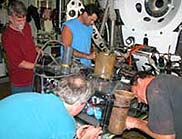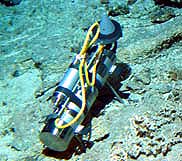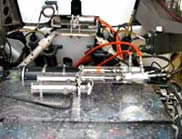|
|
|||||||||||||||||||||||||||||||||||||||||||||||||||||||||||||||||||||||||||||||||||||||||||||||||||
 |
|||||||||||||||||||||||||||||||||||||||||||||||||||||||||||||||||||||||||||||||||||||||||||||||||||
We are four dives into the program and things seem to be going pretty well. Rocks and water and biological samples are coming aboard each day along with hundreds of images from a variety of cameras. This aspect of data collection has settled into a routine thatthe scientists handle with more efficiency each afternoon. Now, I’m hoping, the chaos of sensor and probe implementation can settle down a bit. While I normally deal with fluids and gases collected using Alvin and the CTD, this trip is a little different for me. I have Giora and Ben helping with the gas extractions and gas chromatographic analyses.
My main worry at present is getting a variety of sensors and probes and the appropriate connectors and cables to the Alvin ET’s (electronics group) and the SSSG (shipboard scientific support group) team. Our colleague from Japan, Ko-ichi Nakamura, has provided 3 sensors devoted to measuring eH (a measure of oxidizable chemicals produced at the vents), one for each of Alvin, Abe and the CTD. Of course, each has it’s own unique connecting cable and each has it’s own pair of working electrodes. So far, the ABE package is working fine, we’ve got a good background profile from the CTD and a snippet of data from the Alvin-carried sensor with the hopes of more from today’s dive. We’ve brought along a commercially produced methane sensor to use primarily on the CTD when prospecting for new venting sites (the venting fluids have high methane concentrations) but also to be used on Alvin to evaluate sensor response when put very near the vents. Again, each “platform” (Alvin, CTD) has a unique cable and data collection system to deal with. I’m fortunate to work with specialists out here (Tony, Anthony and Dave) who do these kinds of interfaces with every new science group that comes aboard- they take the various pieces that I bring and turn them into functional instruments.
The next issue for me is preparation of the deployable pressure sensor and resistivity probe. The pressure sensor actually went out on dive 3864 and is sitting on the bottom making measurements. These instruments are not physically cabled to the submarine, yet we can listen to them using an ICL (inductively coupled loop) system designed a few years back by Al Bradley. Once again, it’s cables and loops and a special interface inside the sub to be delivered to the ET’s early on for wiring and testing. Speaking of ICL’s, we also use a special set of small “transmitters” attached to our sampling bottles which measure temperatures at our sampler intakes and transmit the data to a receiver located on the arm of the submarine to aid in getting really good samples; more cables, more connectors.
While care and feeding of the samplers has become somewhat routine, they can be used in different ways that again, require a little help from the Alvin group. Adding a pair of gastight bottles to today’s Beast dive brought me to Bruce and Mark (Alvin mechanics group) for assistance in getting small “rams” prepped to trigger the bottles. This time it’s hydraulic hoses and quick-disconnects to deal with and as with all things that go into the water, there’s some kind of oil, grease or lube used to prepare the instruments (and get on your clothing). The best part of coming out on Atlantis/Alvin is knowing the people well (I’ve sailed with some of those out here for 15 years now), and knowing that they can and will help in any way possible. It makes life a bit less stressful- particularly when ripping through countless boxes looking for that cable with RMG4...I KNOW I PACKED IT SOMEWHERE! |
|||||||||||||||||||||||||||||||||||||||||||||||||||||||||||||||||||||||||||||||||||||||||||||||||||



